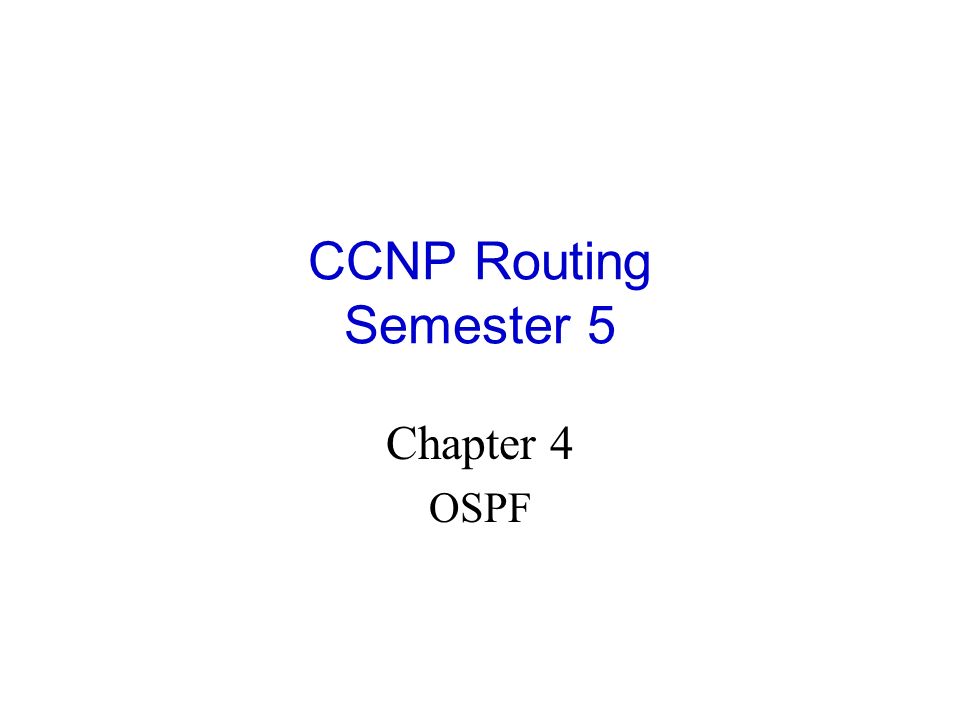
Ccnp Route Ppt Slides
File download on P2P networks, Reliable messaging; in order arrival of. Routing algorithms; Provide a service model to the transport layer; Pass it up to.
CCNP - Advanced Routing Ch. 2 IP Addressing CCNP - Advanced Routing IPv4 Address Classes Class A Network Host Host Host Class B Network 1st octet 2nd octet 3rd octet 4th octet Class A Network Host Host Host Class B Network Network Host Host Class C Network Network Network Host Class A addresses First octet is between 0 - 127 Network Host 8 bits 8 bits 8 bits With 24 bits available for hosts, there a 224 possible addresses. That’s 16,777,216 nodes! Number between There are 126 class A addresses. 0 and 127 have special meaning and are not used. Only large organizations such as the military, government agencies, universities, and large corporations have class A addresses.
Cable Modem ISPs have Pacbell DSL users have Class A addresses account for 2,147,483,648 of the possible IPv4 addresses. That’s 50% of the total unicast address space! Class B addresses First octet is between 128 - 191 Network Network Host Host 8 bits 8 bits With 16 bits available for hosts, there a 216 possible addresses. That’s 65,536 nodes! Number between There are 16,384 (214) class B networks. Class B addresses represent 25% of the total IPv4 unicast address space.
Class B addresses are assigned to large organizations including corporations (such as Cisco, government agencies, and school districts). Class C addresses First octet is between 192 - 223 Network Network Host 8 bits With 8 bits available for hosts, there a 28 possible addresses. That’s 256 nodes! Number between There are 2,097,152 possible class C networks. Class C addresses represent 12.5% of the total IPv4 unicast address space. IP address shortage Subnet Mask In the early days of the Internet, IP addresses were allocated to organizations based on request rather than actual need. No medium size - Hosts: Class A: 16 million Class B: 65,536 Class C: 256 Subnet Mask The solution to the IP address shortage was thought to be the subnet mask.
Formalized in 1985 (RFC 950), the subnet mask breaks a single class A, B or C network in to smaller pieces. Given the Class B address 190.52.0.0 Subnet Example Given the Class B address Class B Network Network Host Host Using subnets. Network Subnet Host Internet routers still “see” this net as But internal routers think all these addresses are on different networks, called subnetworks Subnetting Using the 3rd octet, 190.52.0.0 was divided into: Network Host Using the 3rd octet, was divided into: and so on. Need a Subnet Review? If you need a Review of Subnets, please review the following links on my web site: Subnet Review (PowerPoint) Subnets Explained (Word Doc) Subnetting Let’s look at a class-C address and a 27-bit mask. /27 /27 /27 /27 /27 /27 /27 /27 /24 Class-C address block Subnet First Host Last Host Broadcast /27 Can’t use 000 and 111 (who told you that!?) /27 /27 /27 /27 /27 /27 /27 Can’t use 000 and 111 (who told you that!?) Enabling the use of subnet zero, “0” The Cisco IOS allows you to use subnet 0. On pre-IOS 12.x releases, this feature is not enabled by default.
Router(config)#ip subnet-zero On IOS 12.x releases and later, this feature is enabled by default. This command also enables process of routing updates containing information about zero subnets. Enabling the use of the all 1’s subnet Although this Cisco IOS will allow you to configure addresses in the all-ones subnet, this is highly discouraged. As a general rule, do not use the all-ones subnet. Problems with IPv4 Addressing Address Depletion Internet Routing Table Explosion Long-term solution: IPv6 IP v6, or IPng (IP – the Next Generation) uses a 128-bit address space, yielding 340,282,366,920,938,463,463,374,607,431,768,211,456 possible addresses.
IPv6 has been slow to arrive IPv4 revitalized by new features, making IPv6 a luxury, and not a desperately needed fix IPv6 requires new software; IT staffs must be retrained IPv6 will most likely coexist with IPv4 for years to come. Free download billing explorer deskpro 6 2007 full keygen. Some experts believe IPv4 will remain for more than 10 years.
IPv6 Address format - FYI Unicast: An identifier for a single interface. Anycast: An identifier for a set of interfaces (typically belonging to different nodes). A packet sent to an anycast address is delivered to the “nearest,” or first, interface in the anycast group.